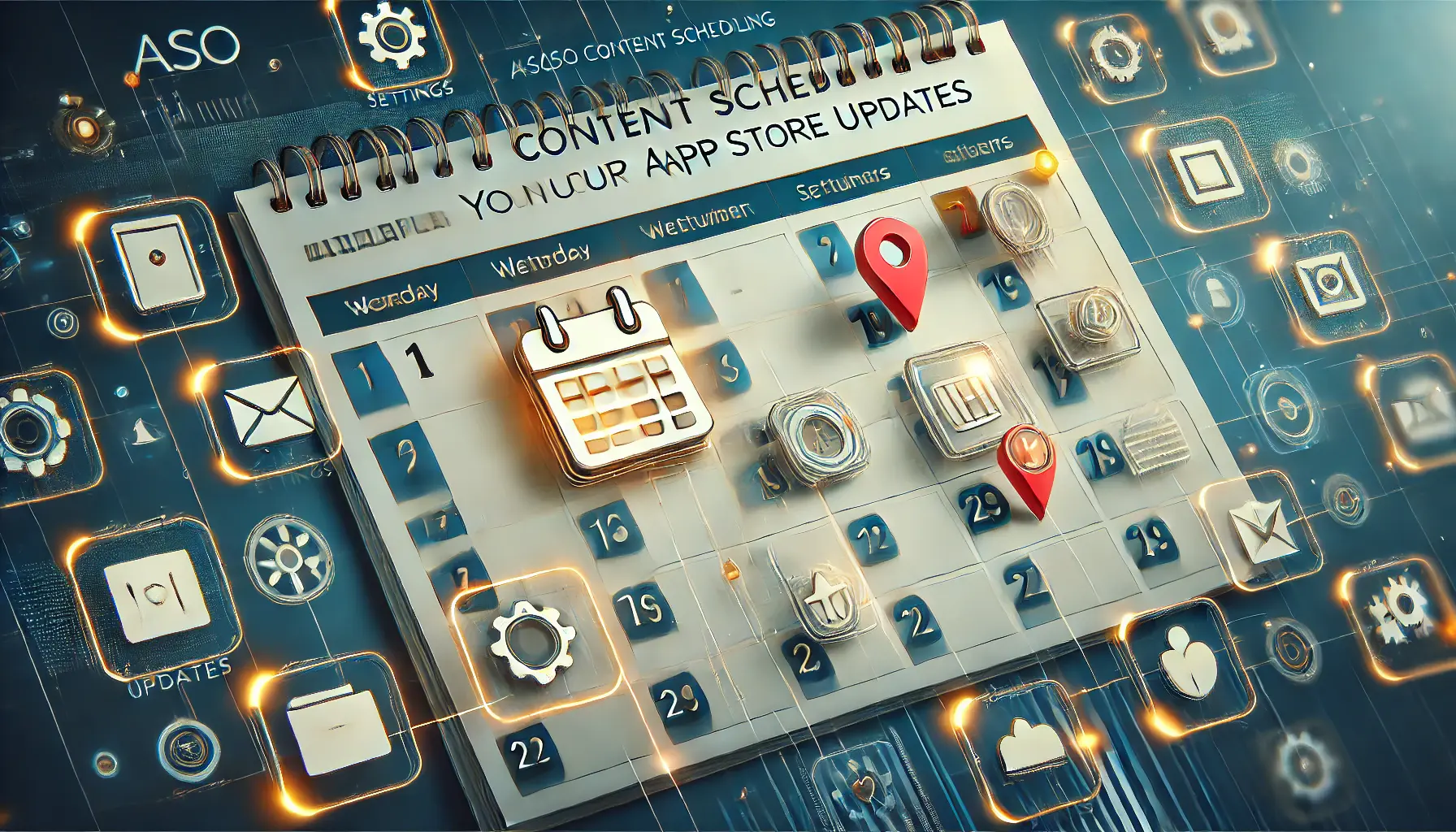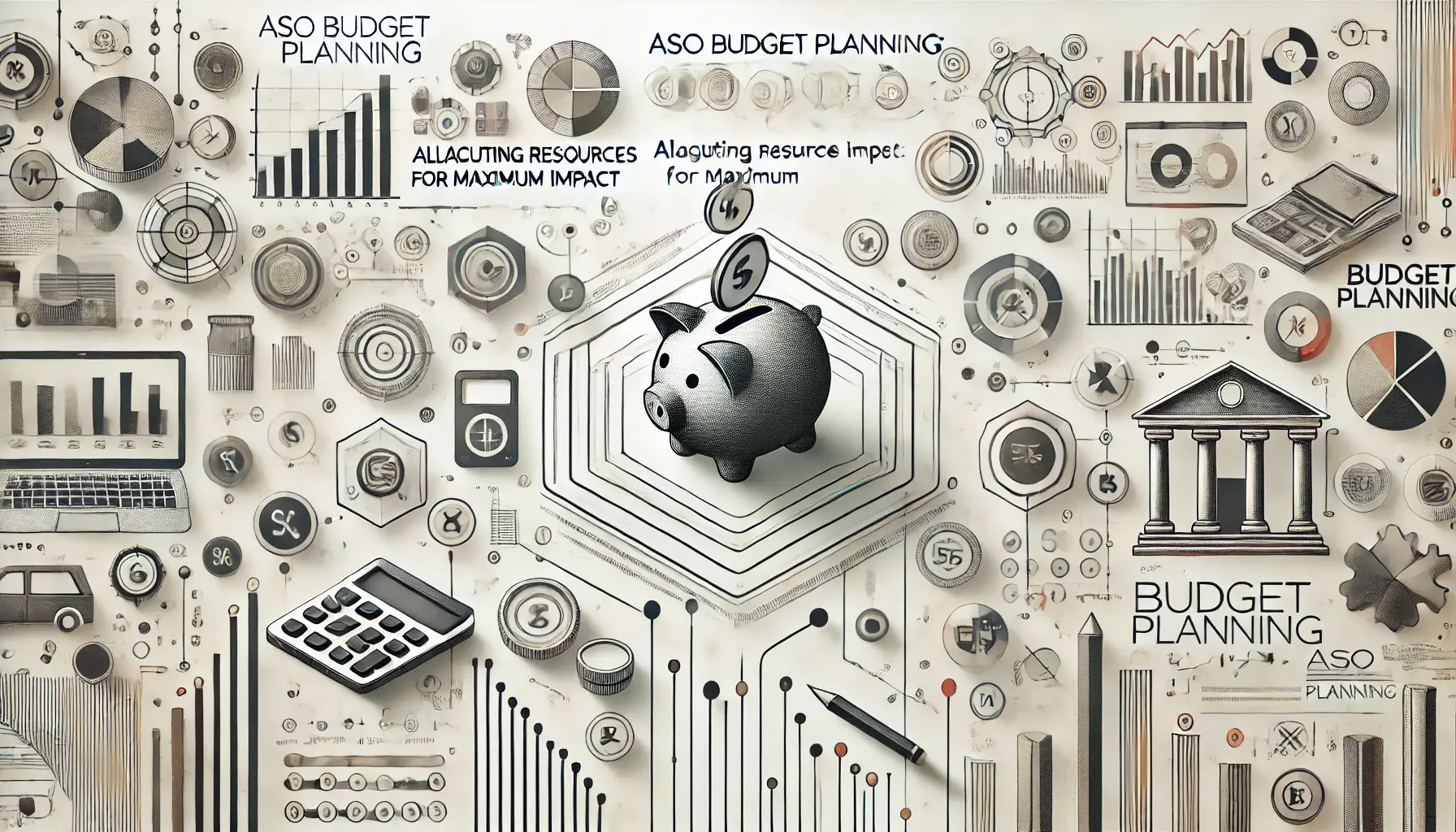In the cutthroat realm of mobile apps, keeping your app top-of-mind (and on users’ home screens) is an absolute must.
One of the essential approaches to steady and uplift your app appearance is ASOApp Store Optimization, a strategy used to improve an app's visibility in app stores. (App Store Optimization) content scheduling.
You can enhance the overall app store optimization, attract more users to download it, as well as maintain your user base so that they do not disappear or switch.
So, what makes a successful content scheduling strategy?
In this post, we will explore some of the key tactics and tools you must consider before planning your visual app store updates.
It really is more than just setting the date of your next update, right?
It includes market research, user and competitive analysis.
This will help boost the visibility of your app and ensure potential users always see something fresh and enticing when they visit its page in any given store.
This approach allows you to stay ahead with ASO content scheduling—keep reading as we discuss the process and how you can create a strategy for your app.
- A Guide to Scheduling ASO Content for App Updates
- Best Practices for ASO Content Scheduling
- How To Make Your ASO Content Schedule Efficient
- ASO Content Optimization for Best Results
- Planning Over The Long-Term: Future-Proof Your ASO Content Strategy
- Bottomline on ASO Content Scheduling
- ASO Content Scheduling Top Questions
A Guide to Scheduling ASO Content for App Updates
One of the most ignored parts in ASO is content scheduling.
This leads us to the question – What is ASO content scheduling anyway?
In other words, it’s planning and structuring your app store content updates so they can help you optimize for better visibility and performance in both app stores.
Content scheduling can be a key to ASO success regardless of whether you are an experienced app developer or just getting started.
Let’s break it down.
ASO content scheduling, in a nutshell, is the planning of when and how you modify different elements on your app store listing—like the description, artwork, presentation, keywords, etc.
Planning this is important because it continues to keep your app content fresh and active, which can also help increase ranking with the algorithms overseeing everything in our beloved App Stores.
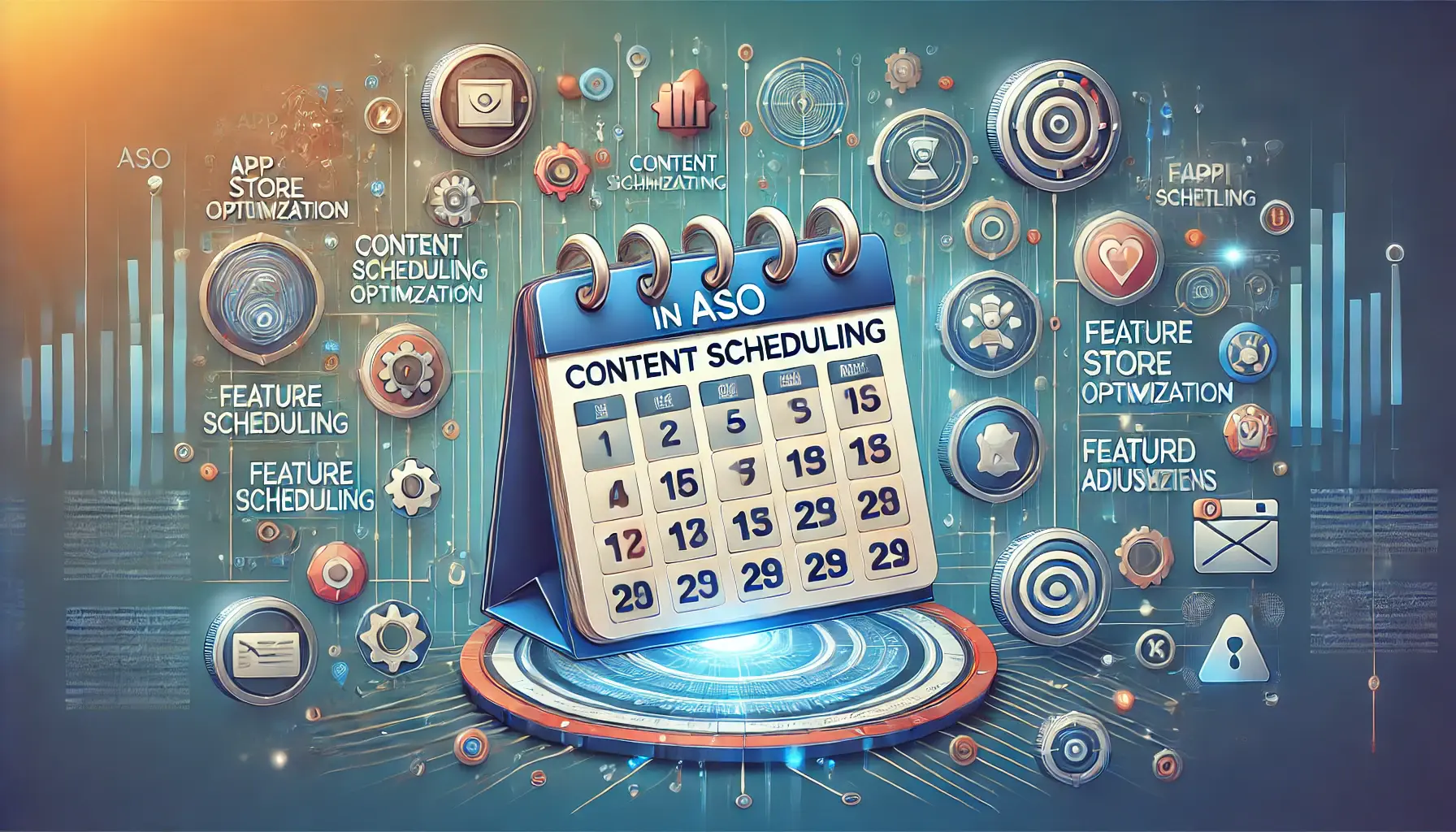
A digital calendar illustrating content scheduling in ASO, featuring tasks like updates and keyword adjustments.
Content Scheduling in ASO
Content scheduling refers to more than just routine updates.
It’s about understanding your targeted audience and how the market works.
For example, weekends might be the best time for some brands to share updates or posts, as they have a unique lifespan that aligns with key moments in your content strategy.
For instance, if you know that your user base spikes during the holiday season, dropping a significant update around this period can help you get more downloads.
What’s more, content scheduling helps you get ahead of your competition!
Regularly updating your content ensures that your app remains relevant and doesn’t get lost in a sea of obscurity.
Additionally, it allows you to experiment with different content strategies, such as A/B testingA method of comparing two versions of content to determine which one performs better., to find the best approach for your app.
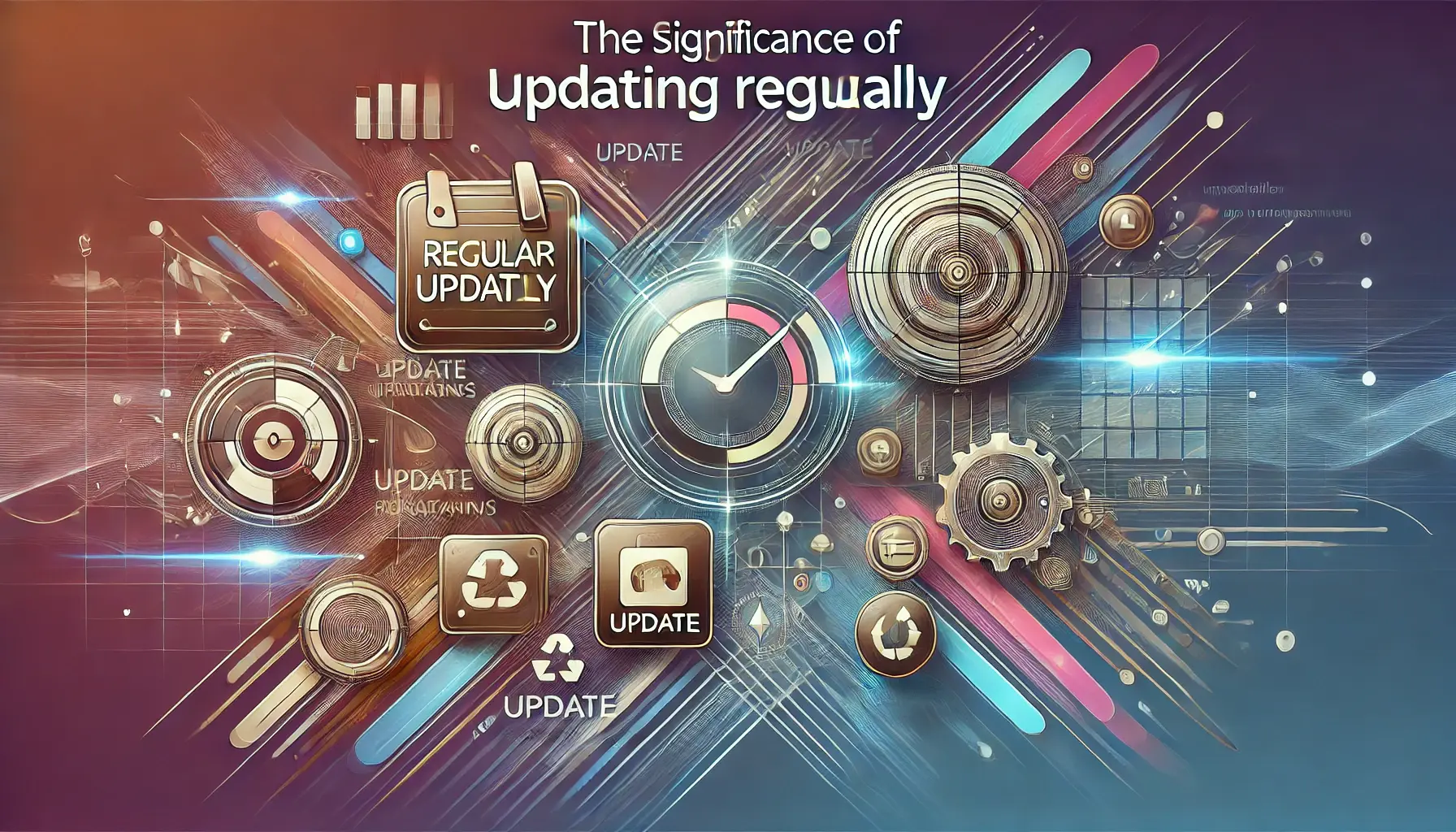
A digital app dashboard emphasizing the importance of regular updates, showcasing progress bars and refreshed app icons.
The Significance of Updating Regularly
Regular updates are essential for several reasons.
First, they demonstrate progress and build trust among your users, showing that you are committed to continuously improving the app.
Users are more likely to download and keep using an app that is frequently updated and well-maintained.
Moreover, continual updates help you stay ahead of changes in app store algorithms or new policies, ensuring that your app remains compliant and continues to perform well.
Another benefit is that consistent updates provide opportunities to refine your ASO strategy.
Every update is a chance to tweak your keywords, optimize screenshots, and make your app even more appealing.
This continuous optimization can gradually improve your app’s ranking, leading to more organic downloads.
But that’s not the full story.
The quality of your updates also matters.
Offering value with each update—whether through new features, bug fixes, or enhanced performance—will keep users coming back and encourage positive reviews, which are crucial for ASO success.
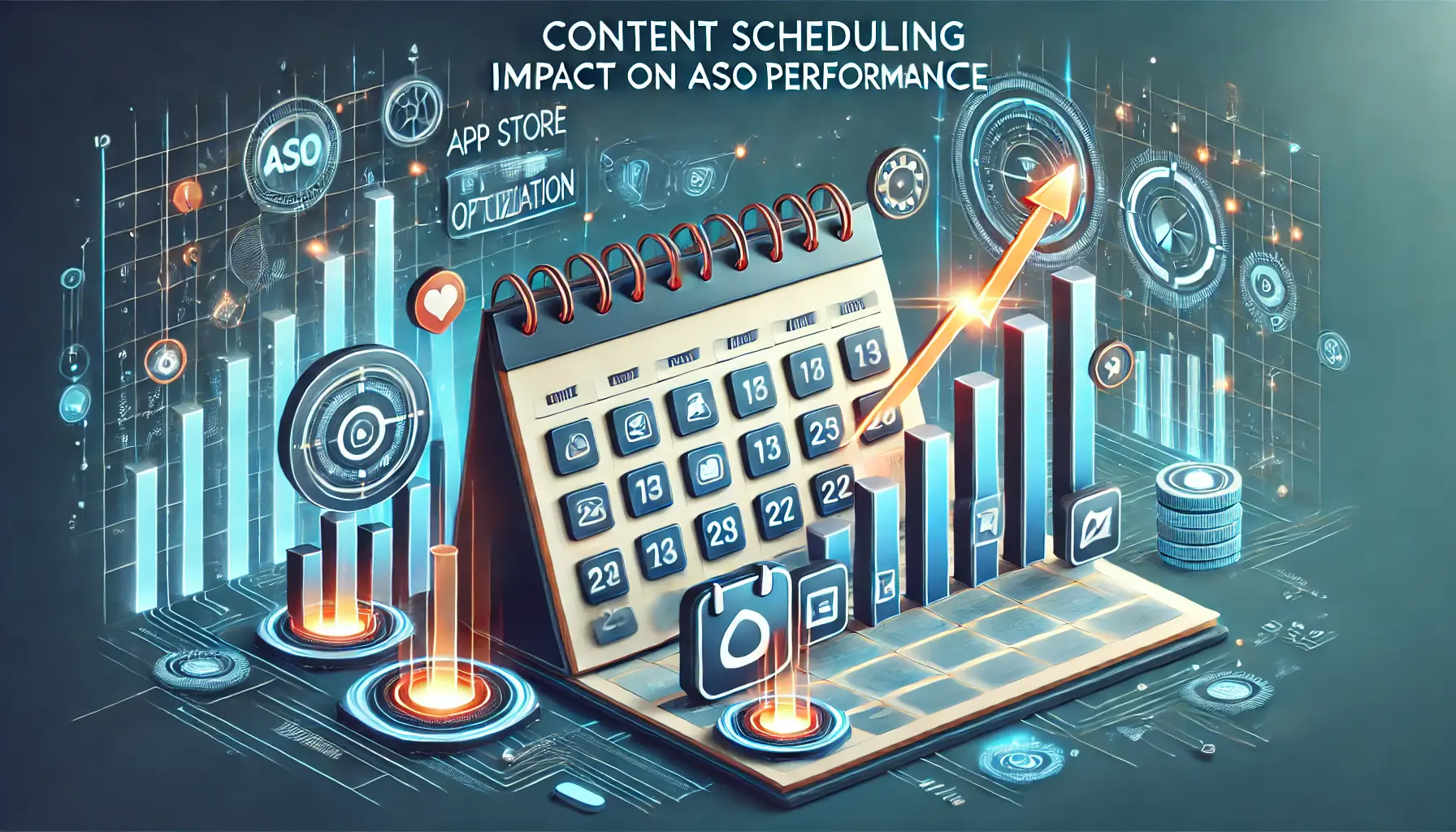
A visual representation of the impact of content scheduling on ASO performance, featuring a rising graph, app icons on a calendar, and growth indicators.
Content Scheduling Impact on ASO Performance
The impact of content scheduling on ASO performance cannot be emphasized enough.
It allows your app to always be optimized for visibility and relevance, keeping you in the good graces of the app stores.
By timely placing your updates, you can align content changes with peak user activity periods, market trends, and even app store algorithm tweaks.
This alignment increases your chances of being featured or promoted by the app store, further boosting your visibility.
Additionally, content scheduling makes resource planning easier on your end, as the content can be scheduled in advance.
This approach helps you manage your team’s time and resources more effectively, ensuring that each update is thoroughly tested and polished before release.
This minimizes the risk of errors or issues that could negatively impact your app’s performance and reputation.
In summary, ASO content scheduling stands out as a powerful tool in your app marketing arsenal.
Preparing your updates in advance puts you ahead of the game, provides users with everything they need, and ensures maximum success on the app store.
Content scheduling keeps your app content fresh and active, which can help increase ranking with the app stores’ algorithms.
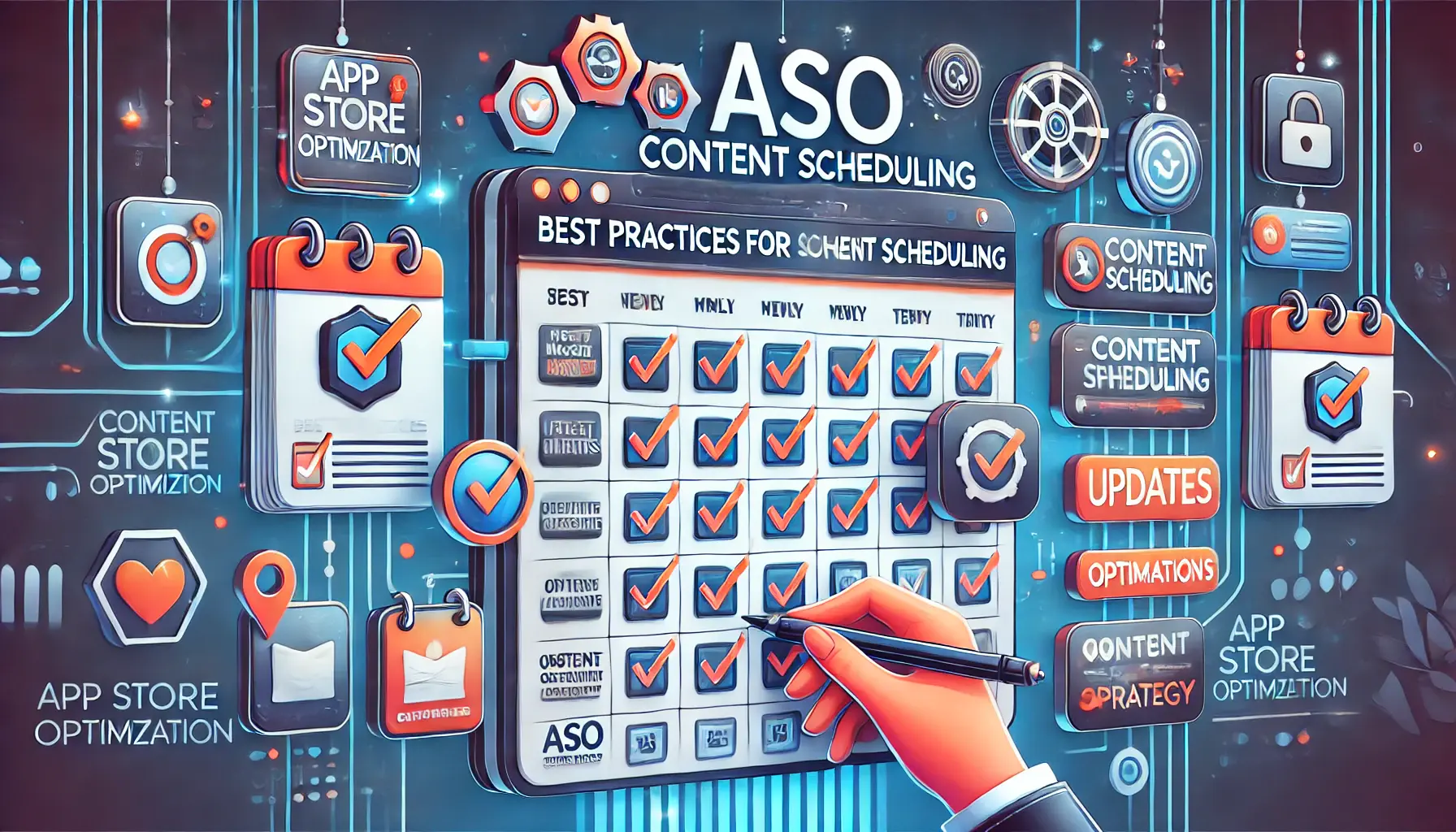
An organized visual of best practices for ASO content scheduling, featuring a checklist, digital calendar, and app-related icons.
Best Practices for ASO Content Scheduling
ASO content scheduling needs a strategic plan.
When we talk about the scheduling of ASO content, it requires proper planning.
Your updates could miss the mark and not get as much bang for your buck if you post without a plan.
To become an expert at scheduling your content, targeting the right stage of users, and staying on trend, you must know who your audience is for your app.
In this post, we discuss the best ways in which you can control your ASO content scheduling efforts to drive results.

A visual representation of matching app updates to market requirements, showing a market analysis graph, app icons on a timeline, and trend indicators.
Matching Updates to Market Requirements
Align Your Updates With Market Trends.
When planning ASO content scheduling, one of the most crucial strategies is that it must be time-bound.
This is essentially about monitoring industry trends, staying aware of your competitors, and figuring out when your target audience is most active on the platform.
If you see a rise in interest in a specific feature or technology, an update that plays off this trend may be just what is needed.
You can also make some seasonal updates during holidays.
The holiday season can bring even more app downloads, so if there are major features you plan to add, this is the right time.
We recommend creating a calendar that lists all industry-related events, holidays, and the seasons when certain types of content are more likely to be consumed.
This helps ensure your updates are timely and relevant.
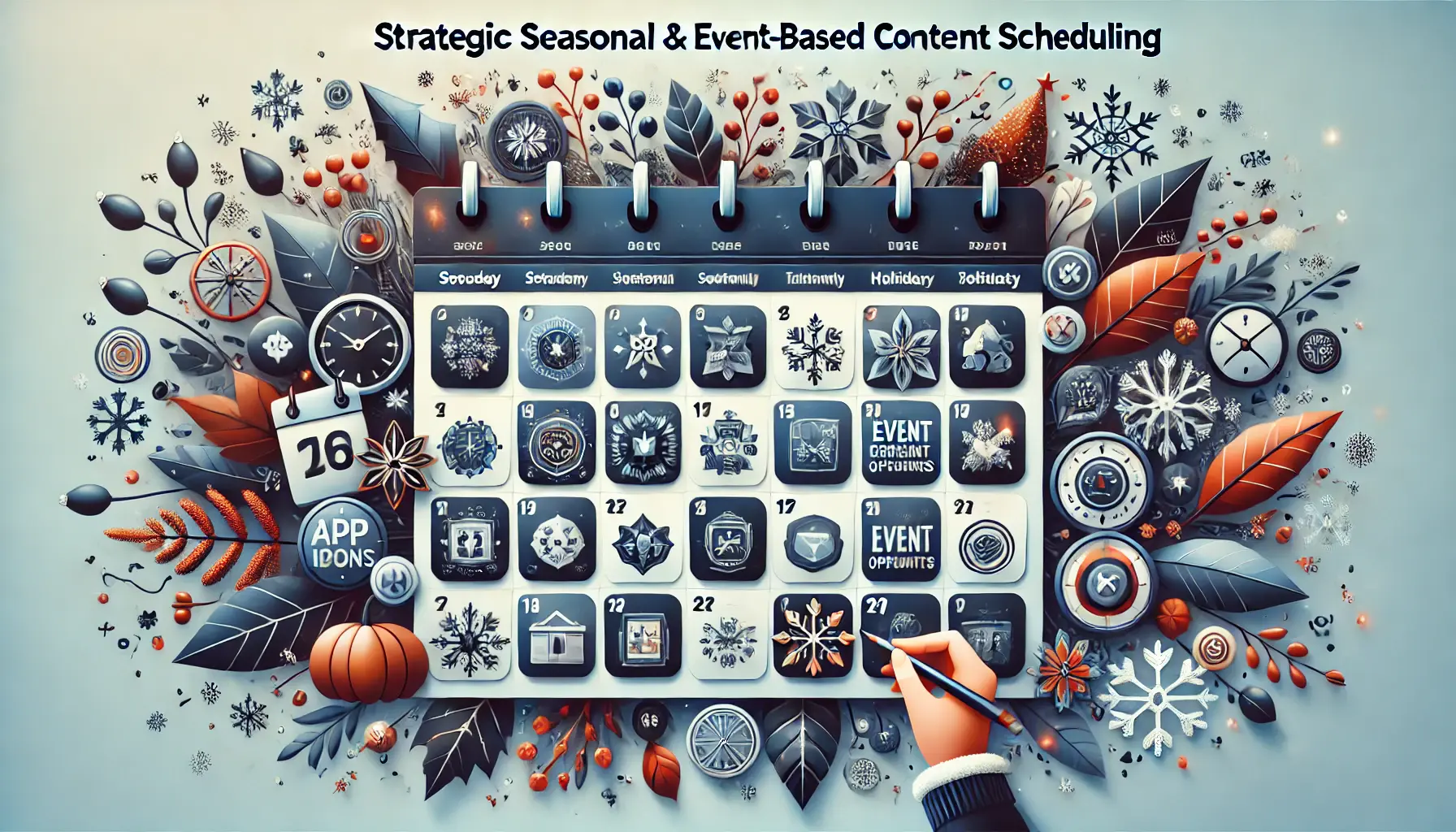
A visual depiction of strategic seasonal and event-based content scheduling, featuring a calendar with seasonal markers and event icons.
Strategic Seasonal & Event-Based Content Scheduling
Based on these insights, you can make your app more visible and attractive by planning content updates tied to seasonal events or industry-specific milestones.
For example, if you have a fitness app, your schedule might revolve around New Year’s when everyone has health and wellness on their mind.
Likewise, a travel app could benefit from updates aligned with popular vacation times.
To implement this effectively, build a content calendar with key dates and events relevant to your app.
Organizing upcoming updates will help you stay up to date with current trends while also ensuring that your updates resonate better with your target audience.
Timing your updates around these events will improve the relevance of your app and increase the chances of getting featured in an app store.
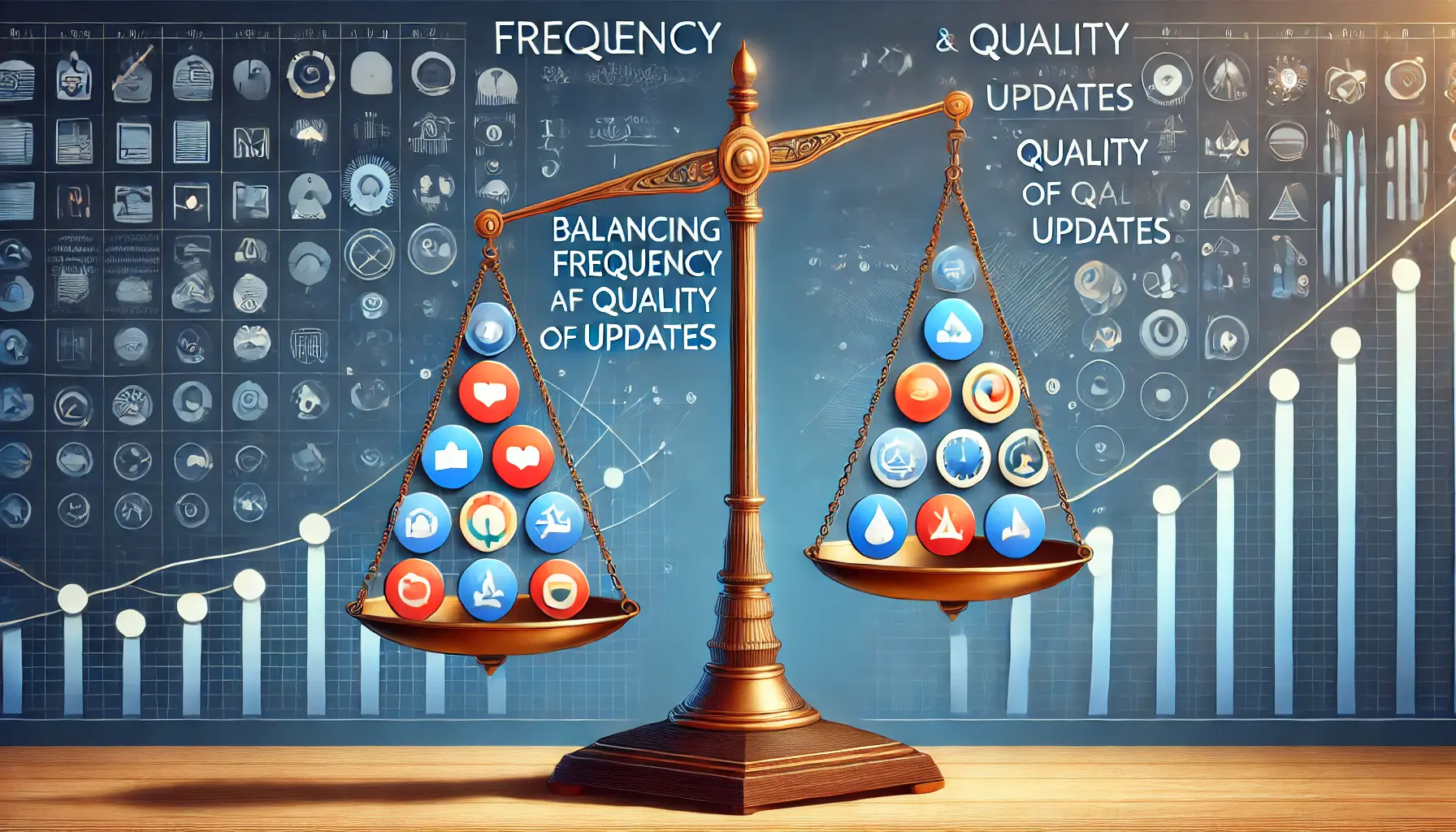
A visual representation of balancing the frequency and quality of app updates, featuring a balanced scale with symbols representing both aspects.
Balancing Frequency and Quality of Updates
Finding the right balance between the frequency and quality of your updates is essential in ASO content scheduling.
While it’s important to keep your app up to date, overloading users with updates in a short amount of time can dilute the experience.
However, not updating often enough can make your app seem inactive and out of touch.
To strike the right balance, publish updates that offer substantial value to your users.
This may include new functionalities, enhancements to existing features, or responding positively to user feedback.
Ensure that everything planned for the update is well-thought-out, rigorously tested, and polished before being released.
By keeping users engaged and making your app useful for long-term use, you can effectively balance frequency with quality in your updates.
In summary, effective ASO content scheduling is a strategic process that takes into account market trends, seasonal opportunities, and maintaining a balance between how often you push out your messaging versus the quality of your content.
Do this, and your app will remain a step ahead of the competition with a steady user base.
ASO content scheduling requires strategic planning to align updates with market trends and user activity.

A visual depiction of efficiency in ASO content scheduling, featuring a streamlined digital calendar, gears representing smooth operation, and a progress indicator showing optimization.
How To Make Your ASO Content Schedule Efficient
A good ASO content scheduling strategy requires the right tools and methods to make sure that changes you are making are appropriate, timely, and effective.
Because there are so many balls in the air, making sure your process is as efficient as possible will help you keep a leg-up on your competition.
Below, we will cover the top methods and tools that can assist with content scheduling in addition to tips to keep your app up-to-date.

A visual representation of the best ASO tools for scheduling posts, featuring a digital dashboard, tool icons, and a calendar for automated scheduling.
Best ASO Tools for Scheduling Posts
There are numerous tools for ASO content scheduling, and each one comes with its own set of features that can enable you to schedule your updates effectively.
Some of the best tools include:
- App Radar: Whether it is about optimizing your app store listings, tracking keyword rankings, or scheduling when to update the content of the apps based on real-time data, App Radar has all bases covered for you.
- Sensor Tower: The powerhouse of data analytics, Sensor Tower gives you a peek into market trends and an understanding of competitor strategies and user behavior to help carve out your update schedule according to industry movements.
- TheTool: With everything you need in one place for your ASO strategy, including keyword tracking, competitor analysis, and update scheduling, TheTool allows you to perfectly plan and execute your updates.
- App Annie: This comprehensive platform provides growth data and market insights that can help you understand when to update the app and increase its visibility.
By using these tools, you can keep track of market trends as well as the performance of your app and plan updates accordingly, ensuring they have maximum impact.
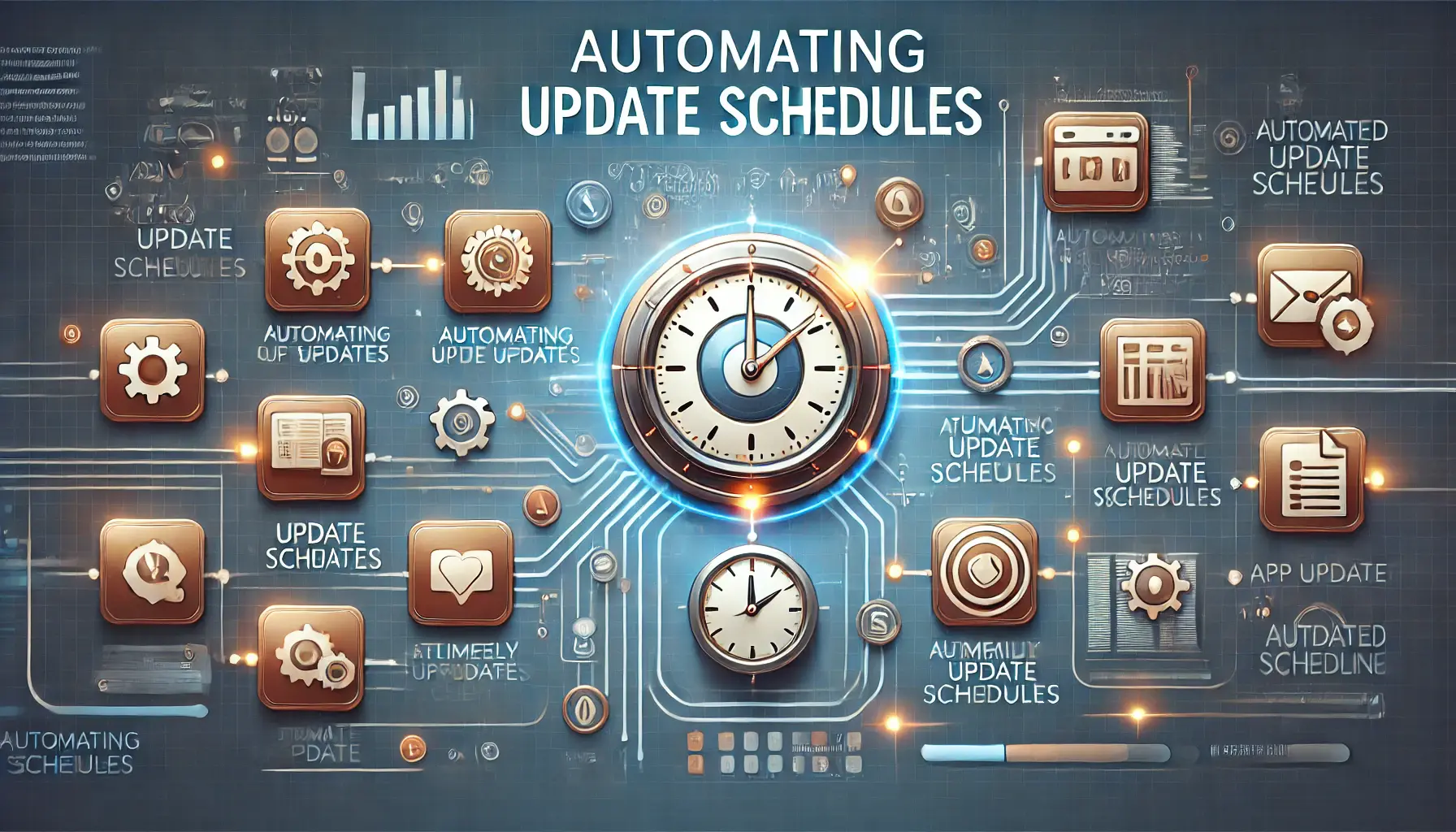
A visual representation of automating update schedules, featuring a digital interface with automated processes, a clock symbolizing timely execution, and app icons being updated on a timeline.
Automating Update Schedules
Automation can be a game-changer in ASO content scheduling.
By automating the process, you can optimize your app without needing to manually intervene all the time.
This enables you to focus more on strategy and less on execution.
Using automation tools, you can:
- Schedule recurring updates on a weekly or monthly cycle.
- Automatically adapt content according to real-time data, ensuring your app stays up-to-date with current trends.
- Increase visibility and downloads by scheduling updates during peak user activity hours.
Integrating automation into your content scheduling allows you to maintain a regular cadence of updates that will constantly refresh your app, keeping it a step ahead of the competition.

A visual representation of observing and analyzing update performance, featuring a digital dashboard with performance metrics, trend graphs, and magnifying glasses focusing on data points.
Observing and Analyzing Update Performance
Even with an ideal schedule for posting your ASO content, it’s essential to track the performance of your updates and analyze them to refine your strategy further.
This entails monitoring key data points to understand what works and what doesn’t, allowing you to make informed decisions for future updates.
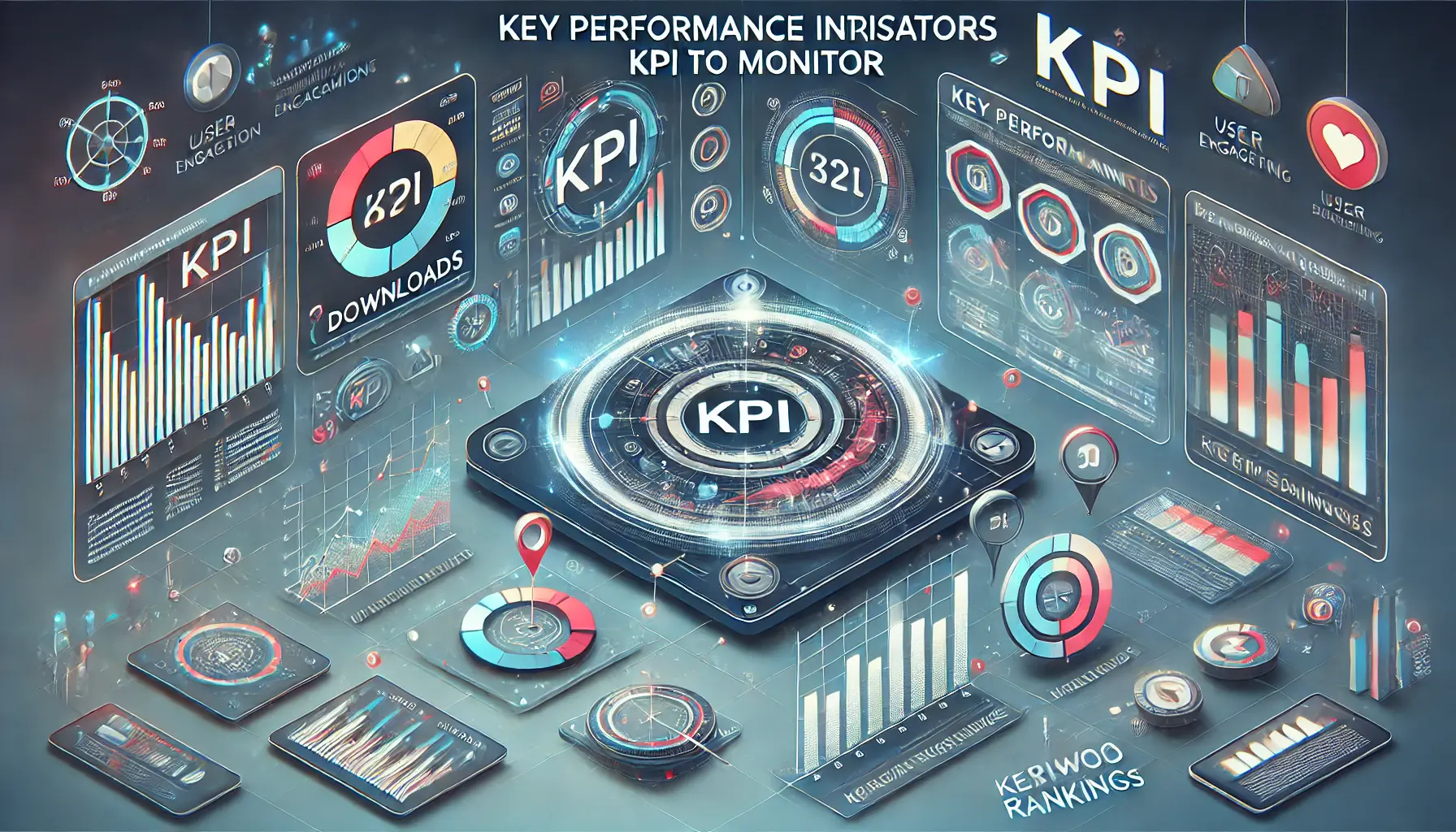
A visual representation of monitoring key performance indicators (KPIs) for app performance, featuring a digital dashboard, KPI metrics, graphs, and dials.
Key Performance Indicators (KPI) to Monitor
- Downloads: Track whether your app is gaining more downloads or losing them after an update.
- Keyword Rankings: Monitor how your app’s keywords are performing after each release, checking whether your changes have improved visibility.
- User Engagement: Observe how users interact with new features—are they staying in session longer and taking more actions?
- User Reviews and Ratings: Evaluate user feedback to determine if updates are well-received or need further improvement.
By continuously monitoring these KPIs, you can refine your ASO content scheduling strategy, ensuring it becomes more effective over time and leads to greater success in the app store.
Automation and the right tools are crucial for efficient ASO content scheduling, allowing you to stay ahead in the competitive app market.

A visual representation of ASO content optimization, featuring app icons being enhanced, a digital interface showing optimization tools, and progress indicators reflecting improvement.
ASO Content Optimization for Best Results
There are some important strategies to be considered in ASO content scheduling rather than just planning and timing your updates.
But if you truly want to get the most bang for your buck, it’s essential to ensure that the content itself is optimized.
This involves making sure that your app store listing description, screenshots, and everything in between are designed not only to acquire users but also to keep them coming back while increasing the discoverability of your application.
Next up, we will focus on the major tweaks you need to make to your ASO content for the best results.
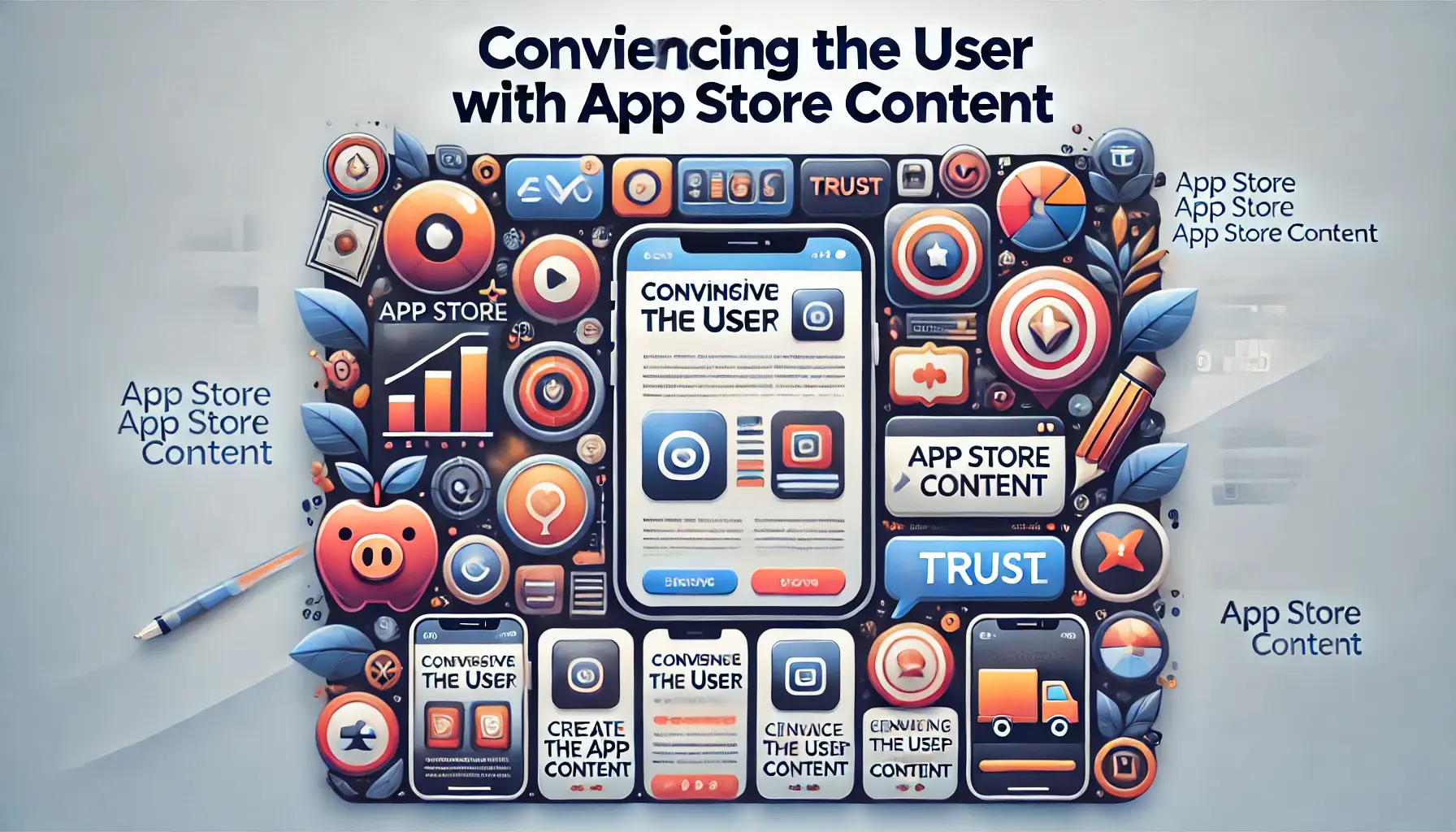
A visual representation of convincing app store content, featuring engaging app listings with appealing icons, screenshots, and a user-friendly interface.
Convincing the User with App Store Content
The very first step in ASO content optimization is creating appealing, high-quality content for your target audience.
This includes:
- App Description: Write a clear and concise description that highlights your app’s key selling points. Sprinkle in targeted keywords naturally throughout the text to improve visibility in search results.
- App Icon: Design a beautiful, eye-catching app icon that reflects your app’s purpose, helping it gain attention in the already crowded app store environment.
- Screenshots & Videos: Use visually attractive screenshots and videos to showcase the highlights of your app’s features. Ensure these visuals accurately reflect the user experience and emphasize what sets your app apart.
- User Reviews: Encourage satisfied users to leave positive reviews, as this can significantly impact your app’s ranking and attractiveness to potential new users.
If you keep these strategies in mind, you can create app store content that not only attracts users but also brings them one step closer to downloading and using your app.
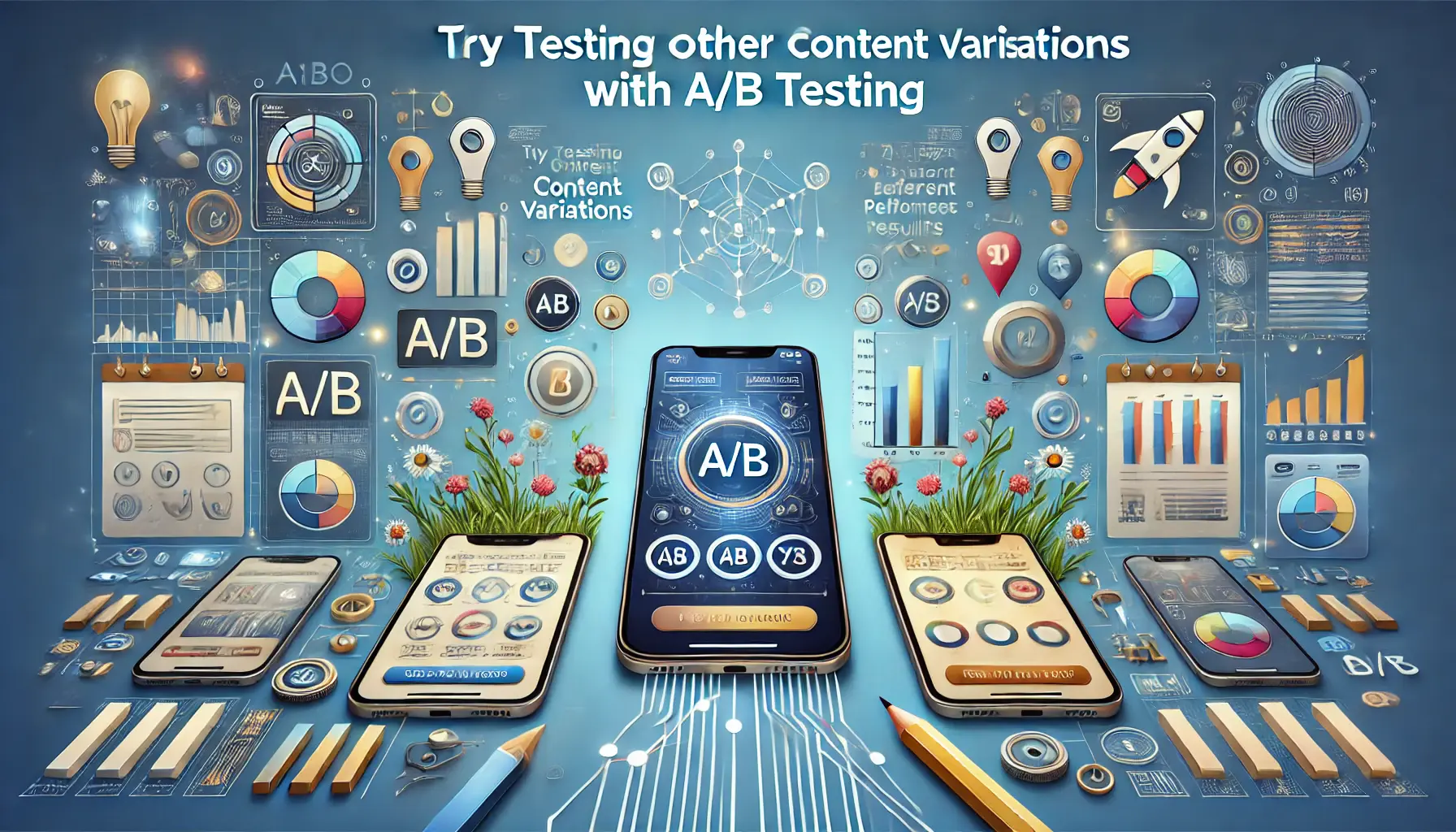
A visual representation of A/B testing different content variations, featuring two app screens with different designs and a performance comparison chart.
Try Testing Other Content Variations with A/B Testing
A/B testing is a powerful tool that allows you to test different iterations of your app store content to see which one converts best.
This can include testing variations in:
- Description: Experiment with different headlines, keywords, and messaging to determine which resonates most with your target audience.
- Visuals: Test different screenshots, videos, or app icons to find the most effective visual representation of your app.
- CTA: Try out different call-to-action (CTA) phrases in your description or visuals to see which drives the most downloads.
Over time, continuously testing and refining your content can give you the confidence that all of your ASO content scheduling efforts are backed by fresh and optimized resources.

A visual representation of applying feedback to adjust content, featuring a digital interface displaying user feedback, a progress bar indicating adjustments, and optimized app icons.
The Rule of 80%: Applying Feedback to Adjust Content
Listening to user feedback is crucial for making your app store content more effective.
Regularly review ratings, reviews, and in-app feedback to identify areas where your app could be improved.
This can help you:
- Identify common pain points or issues that users are experiencing, allowing you to address them in future updates.
- Highlight features that users love and emphasize these in your app store content.
- Understand how your app compares to competitors, helping you differentiate your app more effectively.
Utilizing user feedback is an easy way to improve your content updates and, in turn, enhance the user experience.
It also shows potential users that you are actively working to improve your app.

A visual representation of monitoring competitor updates, featuring a digital dashboard displaying competitor analysis, app icons compared side by side, and performance metrics.
Monitoring Competitor Updates
Last but not least, remember that the app store is a competitive world—so keep an eye on your competition!
Regularly monitor their updates, user reviews, and content strategies to identify trends that your app can capitalize on.
By understanding what works well (and what doesn’t) for your competitors, you can make informed decisions about your own ASO content scheduling and optimization strategies.
In summary, ASO optimization of your content is an ongoing journey that requires continuous testing, adaptation, and changes based on market feedback.
By implementing these strategies, you can ensure that your app store content not only supports your scheduling efforts but also achieves maximum organizational impact and success.
Optimizing your app store content, including descriptions, visuals, and keywords, is essential for improving discoverability and user retention.

A visual representation of long-term planning and future-proofing in ASO content strategy, featuring a timeline extending into the future, evolving app icons, and symbols of growth and sustainability.
Planning Over The Long-Term: Future-Proof Your ASO Content Strategy
ASO content scheduling isn’t just focused on the present; it’s also about planning for the future.
Forward planning is absolutely critical if you want to keep your app standing out among the competition as the app store landscape continues to evolve.
To put it simply—future-proofing your ASO strategy means anticipating changes in market trends, shifts in user behavior, or platform updates, and making sure you have a plan in place for how all of this will affect your app strategy.
In this last part of our series on ASO content scheduling, we will address what you should do for a long-term strategy that will keep working and driving results.
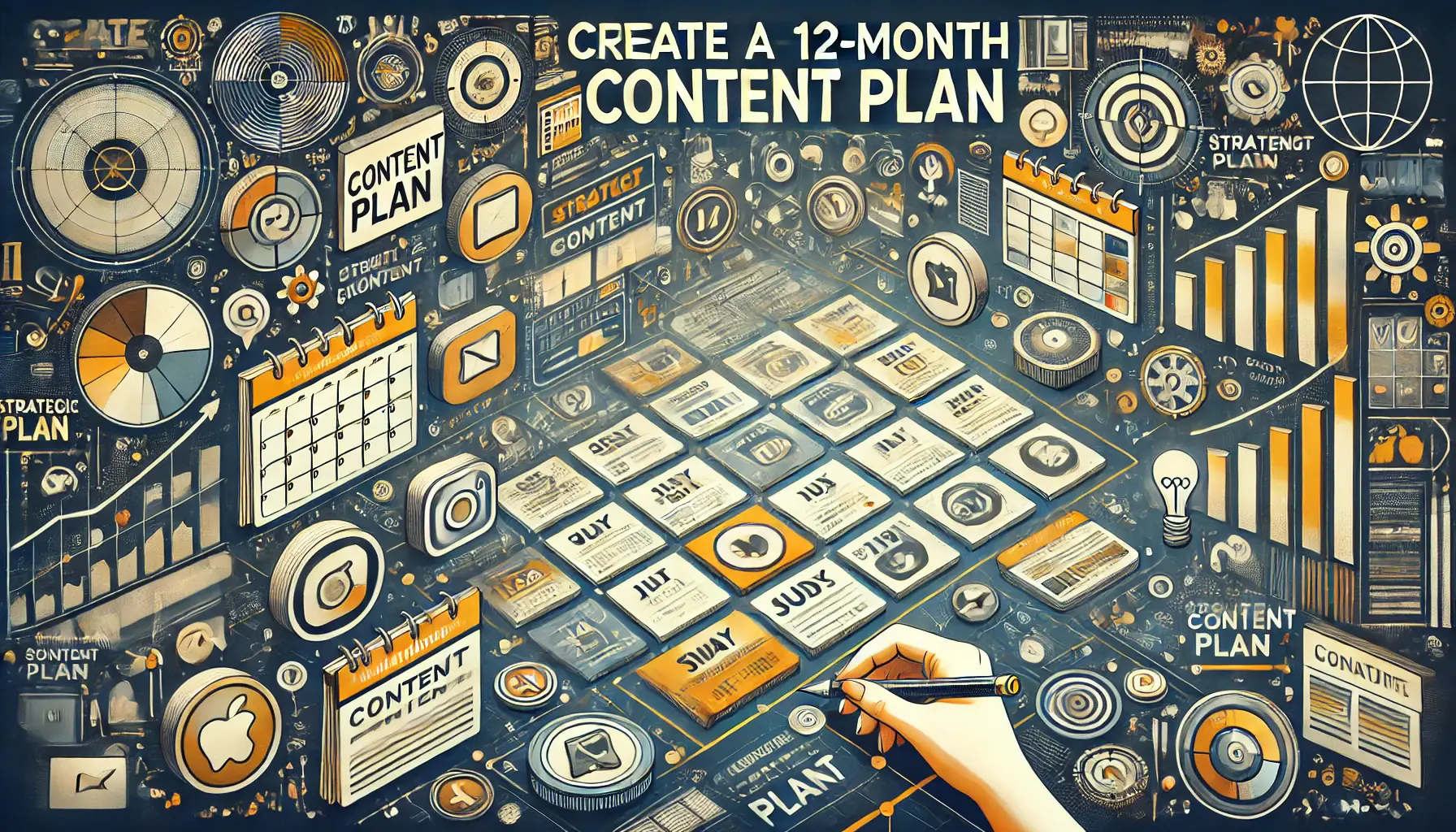
A visual representation of creating a 12-month content plan, featuring a yearly calendar with marked key dates, app icons for different updates, and a timeline showing planned activities.
Create a 12-Month Content Plan
To create a future-proof ASO content schedule, start with a long-term content calendar that outlines all your planned updates over the coming weeks, months, or even years.
It’s important to have a schedule that can adapt to changes in the market or customer feedback, but it should be structured enough to keep you moving towards your goals.
When building out your editorial schedule for the long run, keep these points in mind:
- Make Updates by Season: Time your app updates around important seasons and holidays—especially those that are relevant to your app’s content or user base.
- App Versions: Regularly work on improvements to your app, ensuring users aren’t left with the same version for too long.
- Feature Updates: Continuously update your app with new features based on user feedback and market demand.
- Redraft App Content Over Time: Periodically update your app store material, including descriptions, screenshots, and keywords, to align with current trends.
Keeping a long-term schedule will help you build your app in an evergreen and competitive way.

A visual representation of getting ready for platform changes and updates, featuring a digital interface showing update notifications, app icons being adjusted, and a progress bar indicating readiness.
Getting Ready for Platform Changes & Updates
One challenge in ASO content scheduling is keeping up with platform changes and updates.
The Apple App Store and Google Play regularly update their algorithms, guidelines, and features, affecting your app’s visibility and performance.
Keeping updated with these changes and learning to be nimble is key to future-proofing your ASO strategy.
Here’s how to prepare for future platform changes:
- Educate Yourself: Stay up-to-date with Apple and Google’s announcements about app store updates. Join developer communities and keep yourself informed through online portals.
- Respond Rapidly: When platform changes occur, be ready to adjust your content strategy quickly. This might involve updating keywords, revising your app description, or tweaking visuals to comply with new guidelines.
- Test New Features: Experiment with new app store features, such as app clips or in-app events, to increase the discoverability of your app and drive traffic. Staying ahead of these trends can give you a competitive edge.
By preparing in advance for platform changes, you can keep your ASO content scheduling strategy running smoothly and maintain your app’s visibility and performance.

A visual representation of staying ahead of user behavior and market changes, featuring a digital dashboard displaying real-time user data, market trend graphs, and app icons being adjusted based on insights.
Staying Ahead of User Behavior & Market Changes
Given that user behavior and market trends are constantly evolving, having a flexible ASO content scheduling strategy is crucial.
Regularly analyze user data and market trends to identify shifts in preferences and plan your approach accordingly.
Here are some ways to stay adaptable:
- Analyze User Data: Collect and monitor data on how users interact with your app to identify trends in preferences, such as download rates, session lengths, or depth of navigation within the app.
- Track the Market: Stay aware of your competition and watch for new trends to see how they could impact your app.
- Pivot When Necessary: If you notice a significant shift in user behavior or market conditions, be ready to pivot your ASO strategy. This might involve adjusting your content calendar, developing new features, or targeting a different audience segment.
By staying adaptable and keeping up with evolving user behavior, you can ensure that your ASO content strategy remains effective and your app continues to grow.
In conclusion, planning for the long-term and future-proofing your ASO content scheduling strategy are critical to maintaining success in today’s competitive app store environment.
Creating a schedule that is both flexible and structured, anticipating platform changes, and staying alert to user behavior will keep your app at the forefront for long-term success.
Future-proofing your ASO strategy involves anticipating market changes and continuously adapting your content to stay relevant.
Bottomline on ASO Content Scheduling
Wrapping It Up: This complete guide on ASO content scheduling comes to an end, and one thing is clear: implementing updates in your app’s content without a smart, strategic method is less effective than following a well-thought-out plan.
By getting to grips with the strategies discussed above, you will notice a significant surge in your app’s visibility, user engagement, and overall performance.
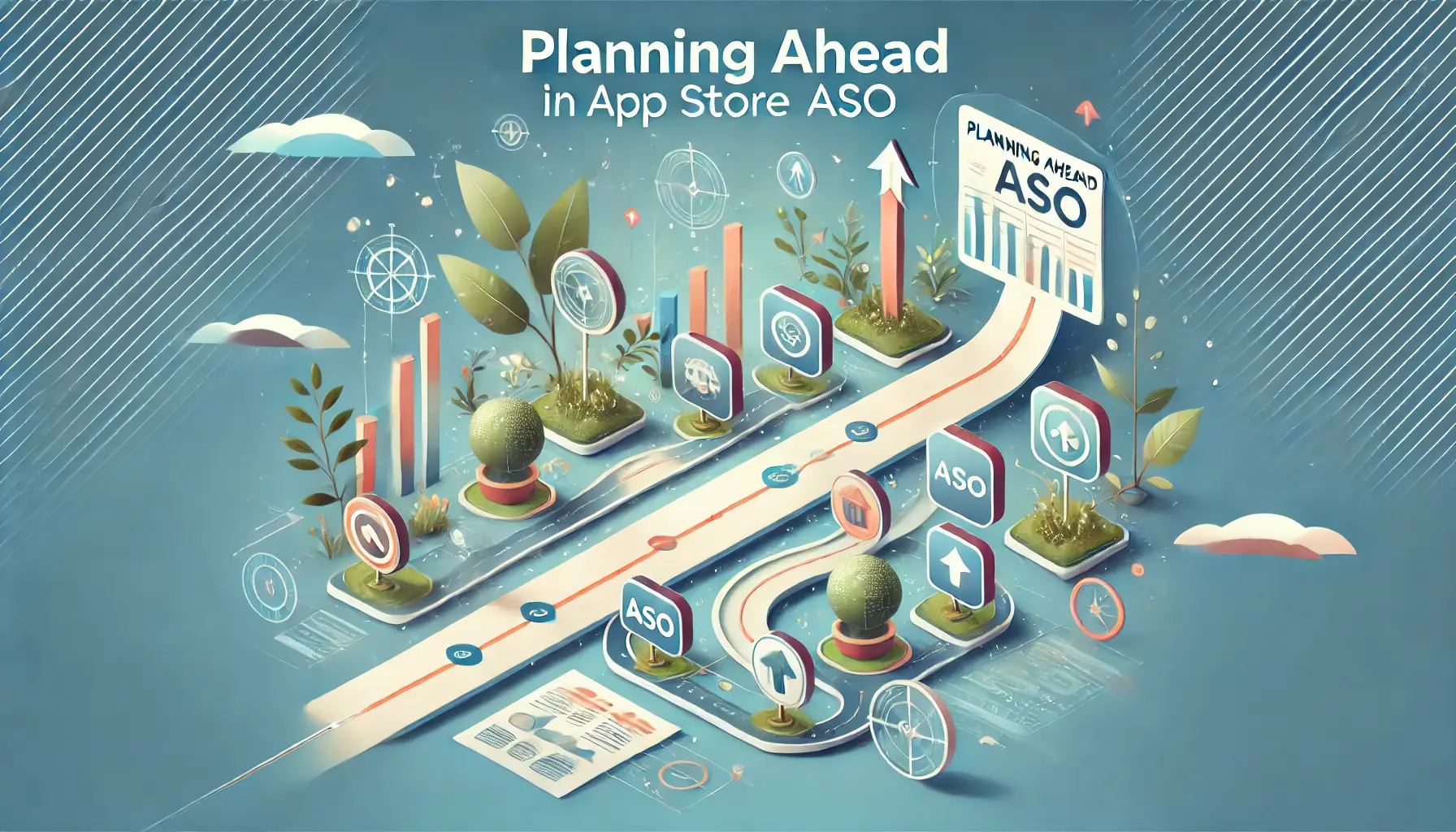
A visual representation of planning ahead for ASO, featuring a roadmap or timeline with app icons placed along the path, and symbols of future growth such as upward arrows or plants.
Planning Ahead for ASO
The big lesson from this article is the importance of good forward planning.
After all, ASO content scheduling is not just about the updates to be released soon; it must also involve long-term planning that monitors trends in market dynamics, user behavior, and platform evolutions.
By creating a 12-month content schedule, you will ensure your content remains fresh and keeps previous app users engaged.

A visual representation of steps for a better future, featuring a pathway or staircase leading upward, with footprints or arrows marking progress and symbols of growth or achievement.
Steps for a Better Future
- Leverage market insights to inform your content strategy.
- Develop a flexible but disciplined content calendar that can be adjusted based on feedback and events.
- Regularly update your app’s features and store content to stay ahead of competitors.

A visual representation of tools and methods for a better program, featuring a digital dashboard showing tools in use, app icons for different functionalities, and symbols of improvement like gears turning smoothly.
Tools and Methods for a Better Program
One of the most important elements in ensuring successful ASO content scheduling is using the right tools and methods.
Automation tools can help you keep your content fresh and optimized without requiring constant manual intervention.
Additionally, A/B testing content variations allows you to determine what resonates most with your audience, leading to more successful updates.

A visual representation of key tools and techniques, featuring a digital interface showing essential tools, icons for different methods, and success symbols like checkmarks.
Key Tools and Techniques
- Use automation tools to keep your content updated and modify it based on real-time data.
- Conduct A/B testing on your app store content for better refinement and impact.
- Monitor performance metrics to track the effectiveness of your improvement efforts.

A visual representation of adapting to platform changes and user behavior, featuring a digital interface showing real-time updates, app icons being modified, and symbols of change like rotating gears or arrows.
Adapting to Platform Changes and User Behavior
Adjusting to platform changes and new behavior trends is crucial for keeping your ASO content scheduling effective.
Keeping track of changes from Apple and Google app stores, and reacting quickly with your content strategy, will help maintain your app’s high visibility.
Additionally, analyzing user data and market trends ensures that your content strategy remains responsive to your audience’s needs.

A visual representation of adapting strategies for key functionality, featuring a digital dashboard showing strategic adjustments, optimized app icons, and symbols of refinement like gears or sliders.
Adapting Strategies for Key Functionality
- Stay informed about platform changes and adapt to new guidelines promptly.
- Research changing user preferences and trends using data analysis.
- Pivot your content strategy as needed to align with market changes.

A visual representation of the key to long-term success through strategic scheduling, featuring a roadmap or calendar with key milestones, strategically placed app icons, and symbols of success like keys or trophies.
The Key to Long-Term Success is Strategic Scheduling
In the end, ASO content scheduling is what will determine your app’s success in the app store.
Combining the right tools with long-term planning and staying open to change will ensure your app not only competes but thrives over time.
Always remember that an ASO content schedule is not a static document but one that evolves as you refine your approach.
If you follow the suggestions in this article, your ASO strategy will be robust and future-proof, allowing your app to sustain its success for years to come.
A well-thought-out ASO content schedule leads to increased visibility, user engagement, and overall app performance.
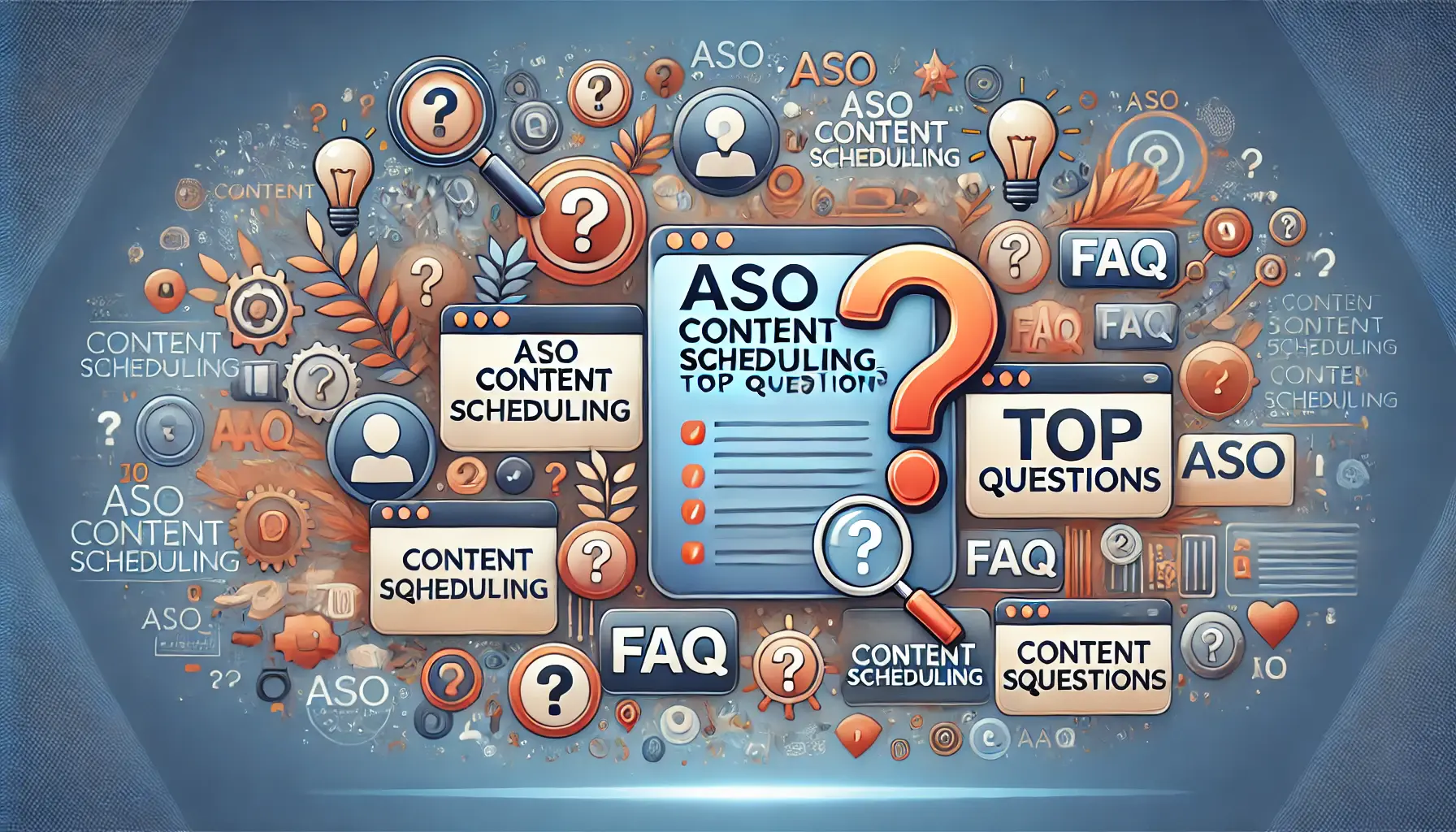
A visual representation of ASO content scheduling top questions, featuring a digital interface displaying question marks, app icons for different topics, and symbols of inquiry like magnifying glasses or lightbulbs.
Boost your mobile app's success with our guaranteed App Store Optimization (ASO) service. Leave it to the experts!
ASO Content Scheduling Top Questions
To help you better understand ASO content scheduling and improve your app’s performance, we have compiled answers to some common questions on this topic.
In short, ASO content scheduling is a framework for planning when and how you will update your app store listing to maximize visibility, user engagement, and overall app performance.
To remain relevant and competitive, you should make regular updates—typically every few months—based on user feedback, market trends, and platform changes.
Use tools such as App Radar, Sensor Tower, and TheTool to assist with ASO content scheduling, automating updates, and performance analysis to fine-tune your ASO strategy.
Thinking ahead allows you to stay competitive by anticipating how market trends, user behavior shifts, and platform updates will affect your app in the future.
